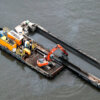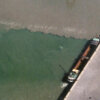Management Practices for the Environment help maximise both environmental and economic benefits and thus the success of dredging activities.
The need for management
While dredging is required to develop and maintain navigation infrastructure throughout the world, dredging can also entail varying degrees of risk to the environment. Protecting the environment is therefore an essential, sometimes crucial, part of planning and managing a dredging project.
One of the first steps before a project actually starts is the execution of an Environmental Impact Assessment (EIA). If this assessment signals that impacts of a project may have significant environmental consequences, Management Practices for the Environment must be evaluated.
The purpose of these Management Practices is to provide guidance for environmental protection and improve the environmental performance of a dredging project.
Management practices to start
Management practices should be initiated before a dredging project begins, in the planning and design phase and should include:
- developing contracts and project management controls,
- using pre-qualification tenders to short-list qualified bidders,
- selecting a contractor based on best value,
- proposing performance standards to allow flexibility, instead of specifying methods, which can limit innovations, and
- preparing a project and site-specific environmental and construction monitoring programme.
Management practices during operations
Process-related management practices are applied to the actual dredging operation including the transportation and placement of dredged material. For example, management practices can determine:
- the selection and possible modification of equipment,
- the modes of construction, i.e., dredging and reclamation methods, and
- the institutional and control tools such as monitoring and feedback, which take into consideration hydraulic conditions (tidal flows and river discharges) as well as timing restrictions for the operation – night or day, weekdays or weekends – or environmental windows, and
- compensatory environmental measures (like creating a new natural habitat or repairing a marine environment or restoring a landscape to offset impacts caused by a dredging project focused on developing a new port).
Risk assessment
Many management practices are available but there is no “one size fits all” and decision makers have to find practices which are suited to a particular project. A risk assessment will help distinguish which management practices are best, by doing a risk analysis based on an examination, comparison and evaluation of alternative practices, and stakeholder input.
Managing risk is a crucial aspect of managing a project. Part of that is reaching out to stakeholders who may see real or perceived risks unknown to the owner or contractor of the project. By addressing these risks and working in a transparent way with open lines of communication to the public and the media wider sense of ownership of a project will develop.
Best Management Practices
The ultimate goal is to find best management practices that will pave the way to reasonable solutions, reduce stakeholder resistance to projects and contribute to the overall improvement of quality of life. By integrating science, economics, legal and societal interests, these best management practices will lead to a better project management and a better project.






































